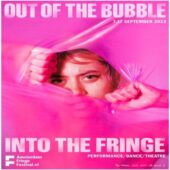Camden Fringe 2009
Low Down
Do Look Back In Anger is a collection of five scenes in which famous literary characters “escape the pages of their works and allow you to look at them in a new light.” Wuthering Heights’ Catherine Earnshaw, Hamlet, Lady Macbeth, Alison Porter and, somewhat incongruously, Tennessee Williams’ Babydoll, tell their stories through a mixture of monologues and sketches.
Review
The show aims to re-imagine great literary works and pose interesting what-ifs and retellings of epic stories from different points of view. Can we change our mind about these much-loved characters? Well, probably not.
Emma Hutchins is undoubtedly a capable writer and performer, previously gaining critical acclaim at the 2008 Edinburgh Fringe for Not Stalking David Tennant, but here she has given herself a somewhat thankless task. In attempting to give a new voice to such established characters she tends to over-explain and runs the risk of repeating herself or stating the obvious. However, there are some nice truthful moments as she explores what her characters can’t and don’t say on stage or in the book.
It’s a mixed bag of scenes varying in tone and quality. Sometimes it feels like nothing new is actually being said and the ironies soon wear thin. Modernising Hamlet as a ‘bird, booze and fags’ chav seems like an incredibly GCSE drama idea – yes, we understand the joke that off-the-page Hamlet has been misrepresented as an effete depressive by Shakespeare. But is it a joke worth sustaining for 15 minutes? And is it funny enough just to make reference to characters from the play in a new context; or to make Hamlet swear like a Jeremy Kyle show guest; or to replicate the alas-poor-Yorrick skull pose with a football? The result is slightly cringe-worthy and not as clever as it thinks it is.
But in this slightly inconsistent piece are some good performances, some good accents and some good lines. Hutchins’ southern States twang is good, and her turn as Babydoll (of eponymous film by Elia Kazan) is charming and more believable than her characterisation of Bronte’s Cathy. Her stage partner Steven George is a strong performer, but inevitably underused.
Curiously the conceit works best with Lady Macbeth, a nicely understated piece which takes place before the main action of Shakespeare’s play. Hutchins characterises Lady M as a quietly-spoken lonely woman desperately in love with an absent husband. The idea of a love story about to “turn into a tragedy” makes the most of the audience’s knowledge of the play without being too ironic. As such it comes across as the most emotionally authentic of the scenes even as it challenges us to make comparisons with the gruesome reality of what is to come.
The concept is potentially limitless – every character in literature could appear, but it is still unlikely you’d learn anything that wasn’t in the original text, or indeed, subtext. And that’s what feels wrong about this project; it kills all that beautifully crafted subtext. Osborne’s Alison Porter can’t reach any closure in Fictional Character Therapy because she’s Alison Porter from Don’t Look Back In Anger. She doesn’t scream at Jimmy, she doesn’t make any claims for herself or tell Jimmy to sod off. And even if Hutchins thinks she should, Alison Porter is not that person. Her frustration and hurt is between the lines, and that’s the beauty of it, that’s what audiences in the 60s took away from the play and it’s what audiences now take from it. In psychoanalysing her for the 21st century, she is reduced to spouting a one dimensional rant which explains that which is already there in the original play, and indeed, which Osborne intended to be repressed and complex.
The engagement with and exploration of literature through drama is worthy and interesting, and Hutchins and George are genuine in this, pitching their performances well. Whatever the flaws, the audience smiled at the literary in-jokes, were moved by Lady M and seduced by Babydoll (even if no-one seemed to know who she was). The author is respectful of the original work, interpretative and creative, if occasionally unsubtle. Hit and miss in effect, the show perhaps needs some reworking and rethinking, but contains much to like and admire.


































